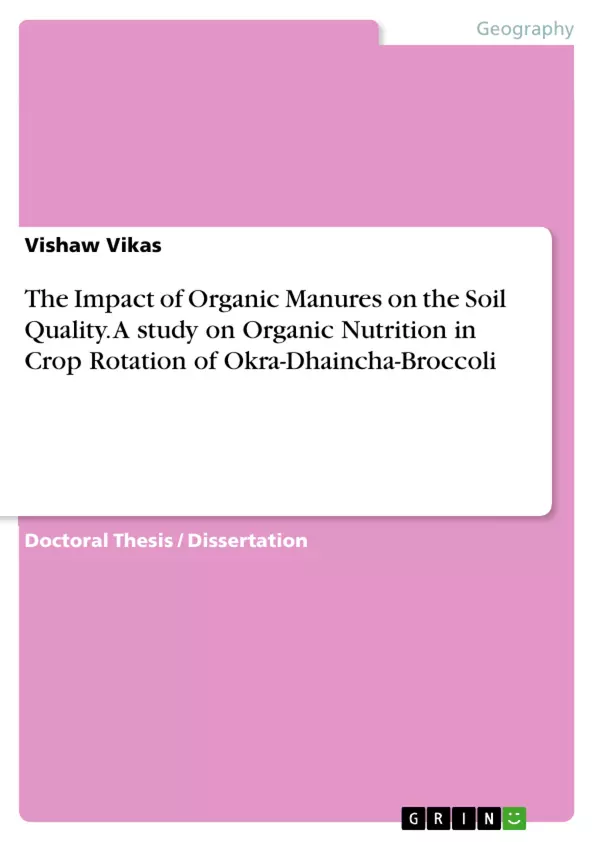A study was conducted to assess the impact of different organic manures on soil properties and growth parameters in okra-broccoli cropping sequence. Study area lies in between 32°39' N latitude and 74°47' E longitude at an elevation of 332 meters above the mean sea level in the Shivalik foothill plains of North-Western Himalayas. Surface soil sampling from 0-15 cm depth was done randomly from four spots of the field prior to start of the experiment.
The data on various characters studied during the course of investigation were statistically analyzed by using Tukey’s test with an aim to figure out which groups in our sample differ by using Honest Significant Difference. Further, influence of organic manures on soil physical, chemical and biological properties was studied and was found that there was a significant impact of organic manures on soil physical properties viz. WHC, BD and IR.
In nutrient status, organic manures reviewed a positive impact on Available N, P and Fe. However, available K, S, Zn, Cu, Mn, Total N, Exch. Ca and Mg were found to be non-significant in the experiment. All growth parameters of okra and broccoli including okra yield and curd weight showed significant increase except number of leaves in broccoli.
Inhaltsverzeichnis (Table of Contents)
- Abstract
- Chapter 1
- Chapter 2
- Chapter 3
- Chapter 4
- Chapter 5
- Chapter 6
- References
Zielsetzung und Themenschwerpunkte (Objectives and Key Themes)
The main objective of this study was to evaluate the impact of various organic manures on soil properties and the growth parameters of okra and broccoli in a cropping sequence. The research aimed to determine the effects of these manures on soil physical, chemical, and biological properties, as well as on the yield and other growth characteristics of the crops.
- Impact of organic manures on soil properties
- Influence of organic manures on okra and broccoli growth
- Analysis of soil physical properties (WHC, BD, IR)
- Assessment of soil chemical properties (pH, EC, OC, CEC)
- Evaluation of soil biological properties (MBC, dehydrogenase activity)
Zusammenfassung der Kapitel (Chapter Summaries)
Abstract: This study investigated the effects of different organic manures on soil properties and growth parameters of okra and broccoli in a cropping sequence. The research was conducted in the Shivalik foothill plains of the North-Western Himalayas. Results showed significant impacts of organic manures on several soil physical properties, including water holding capacity, bulk density, and infiltration rate. While some chemical properties showed non-significant changes, cation exchange capacity (CEC) was significantly improved. Available nitrogen, phosphorus, and iron also showed positive responses to organic manure application, impacting the growth parameters of both okra and broccoli positively.
Schlüsselwörter (Keywords)
FYM, Poultry Manure, Vermicompost, Neem Cake, Soil properties, Okra, Broccoli, Soil physical properties, Soil chemical properties, Soil biological properties, Crop yield, Growth parameters.
Frequently Asked Questions: Impact of Organic Manures on Soil Properties and Growth of Okra and Broccoli
What is the main objective of this study?
The main objective was to evaluate the impact of various organic manures (FYM, Poultry Manure, Vermicompost, Neem Cake) on soil properties and the growth parameters of okra and broccoli in a cropping sequence. This included assessing the effects on soil physical, chemical, and biological properties, as well as crop yield and growth characteristics.
What key themes are explored in this research?
Key themes include the impact of organic manures on soil properties (water holding capacity, bulk density, infiltration rate, pH, EC, OC, CEC, MBC, dehydrogenase activity), the influence of these manures on okra and broccoli growth, and the analysis of soil physical, chemical, and biological properties.
What specific soil properties were analyzed?
The study analyzed several soil properties including water holding capacity (WHC), bulk density (BD), infiltration rate (IR), pH, electrical conductivity (EC), organic carbon (OC), cation exchange capacity (CEC), microbial biomass carbon (MBC), and dehydrogenase activity.
What were the key findings regarding the impact of organic manures on soil properties?
Results showed significant positive impacts of organic manures on several soil physical properties, such as water holding capacity, bulk density, and infiltration rate. While some chemical properties showed non-significant changes, the cation exchange capacity (CEC) was significantly improved. Available nitrogen, phosphorus, and iron also showed positive responses to organic manure application.
How did organic manures affect the growth of okra and broccoli?
The positive changes in soil properties resulting from organic manure application positively impacted the growth parameters of both okra and broccoli. Specific details on the extent of this impact are not provided in this summary.
What types of organic manures were used in this study?
The study utilized Farm Yard Manure (FYM), Poultry Manure, Vermicompost, and Neem Cake as organic manures.
Where was this research conducted?
The research was conducted in the Shivalik foothill plains of the North-Western Himalayas.
What are the key words associated with this research?
Key words include FYM, Poultry Manure, Vermicompost, Neem Cake, Soil properties, Okra, Broccoli, Soil physical properties, Soil chemical properties, Soil biological properties, Crop yield, and Growth parameters.
What chapters are included in this publication?
The publication includes an abstract, six chapters (Chapter 1 through Chapter 6), and a references section.
- Citar trabajo
- Vishaw Vikas (Autor), 2019, The Impact of Organic Manures on the Soil Quality. A study on Organic Nutrition in Crop Rotation of Okra-Dhaincha-Broccoli, Múnich, GRIN Verlag, https://www.grin.com/document/519898



